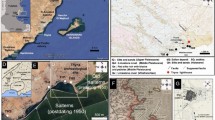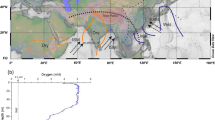Abstract
The time transgressive Cretaceous sedimentation in northeast Indian craton is represented by the deposition of the Upper Cretaceous Mahadek sediments in Meghalaya. The Lower unit of these sediments is comprised of alternate sandstone and conglomerate horizons, and the Upper unit is composed of arkosic to sub-arkosic sandstones. These sediments are overlain by the calcareous litho-units of Langpar Formation of Cretaceous–Paleocene age. Lithofacies identified from various exposures and studied lithologs reflect a variation from marginal marine to marine depositional set-up in the Mahadek sediments. The Lower Mahadek facies is dominated by large-scale trough beds of medium to coarse-grained sediments which initiates with a conglomerate horizon succeeded by thin beds of shale and fine-grained sandstone with parallel laminations, which are followed by successive deposition of gritty sand and pebbly beds with coarsening upward sequence, suggesting product of delta plain in a marginal marine setting. Moreover, the bioturbated coaly fine-grained sandstone is further representative of tidal flat-tidal channel swamp formed in reducing condition and the trace fossil assemblages depict the channel fills. The Upper Mahadek facies is dominated by glauconitic-gritty fossiliferous sandstone showing fining upward sequence and hummocks, typical of marine environment. This fining upward sequence along with the vertical and lateral facies variation implies superimposition of retrograding shorelines on an earlier progradational alluvial fan sand complex. These different-scale cycles are interpreted as the sedimentary response to movements of the basin margin faults at variable frequencies, related to the contemporary faults. This depositional model of the Cretaceous sediments may further help in paleogeographic reconstruction of the northeast Indian craton during the Cretaceous period.













Similar content being viewed by others
Data availability
Available.
Code availability
Not applicable.
References
Acharyya, S. K. (1990). Pan-Indian Gondwana plate break-up and evolution of the Northern and Eastern collision margins of the Indian Plate. Himalayan Geology, 1, 75–91.
Acharyya, S. K. (2005). Geology and Tectonics of NE India. Journal of Geophysics, 26(1), 35–49.
Acharyya, S. K., & Lahiri, T. C. (1991). Cretaceous palaeogeogrphy of the Indian sub-continent; a review. Cretaceous Research. https://doi.org/10.1016/0195-6671(91)90024-7.
Bhattacharjee, P., Rengarajan, M., Srivastava, S. K., Hamilton, S., & Mohanty, R. (2017). Palaeochannel-controlled depositional features of the Cretaceous Lower Mahadek uranium mineralisation in Umthongkut Area, West Khasi Hills, Meghalaya. Journal of Geological Society of India, 90(2), 129–258.
Boote, R. D., & Kirk, R. B. (1989). Depositional Wedge Cycles on Evolving Plate Margin, Western and Northwestern Australia. American Association of Petroleum Geologists Bulletin. https://doi.org/10.1306/703C9B13-1707-11D7-8645000102C1865D.
Casshyap, S. M. (1968). Huronian Stratigraphy and Paleocurrent Analysis in the Espanola-Willisville Area, Sudbury District, Ontario, Canada. Journal of Sedimentary Research. https://doi.org/10.1306/74D71AAF-2B21-11D7-8648000102C1865D.
Chatterjee, S., Goswani, A., & Scotese, C. R. (2013). The longest voyage: Tectonic, magmatic, and paleoclimatic evolution of the Indian plate during its northward flight from Gondwana to Asia. Gondwana Research. https://doi.org/10.1016/j.gr.2012.07.001.
D’cruz, E., Mathur, S. K., Sachan, A. S., Sen, D. B., & Dwivedy, K. K. (1996). Depositional systems and their bearing on the ore grade mineralization in Cretaceous Domiasiat Uranium Deposit, West Khasi Hills District, Meghalaya. Memoir Geological Society of India, 37, 387–403.
Desikachar, O. S. V. (1974). A review of the tectonic and geological history of eastern India in terms of ‘plate tectonics’ theory. Journal of Geological Society of India, 33, 137–149.
Dickinson, W. R. (1985). Interpreting provenance relations from detrital modes of sandstones. In G. G. Zuffa (Ed.), Provenance of arenites (pp. 333–361). Holland: D Reidel Publishing Company.
Dickinson, W. R., & Suczek, C. A. (1979). Plate tectonics and sandstone compositions. Bulletin of American Association of Petroleum Geologists, 63, 2164–2182.
Evans, P. (1932). The Tertiary succession in Assam: Geology and Metallurgy Institute of India. Transactions in Mineralogy, 30, 174–233.
Folk, R. L. (1980). Petrology of sedimentary rock. Austin: Hemphill Publishing Company.
Gorur, N. (1992). A tectonically controlled alluvial fan which developed into a marine fan-delta at a complex triple junction: Miocene Gildirli Formation of the Adana Basin, Turkey. Sedimentary Geology, 15, 8–10. https://doi.org/10.1016/0037-0738(92)90073-Z.
GSI. (2009). Geology and Mineral Resources of Meghalaya (Vol. 29). Shillong: Geological Survey of India Misc Pub. Part IV. (ii).
Hay, W. W., Voigt, S., & Soeding, E. (1999). Alternative global Cretaceous paleogeography. Special Paper Geological Society of America. https://doi.org/10.1130/0-8137-2332-9.1.
Ingersoll, R. V. (1990). Actualistic sandstone petrofacies: discriminating modern and ancient source rocks. Geology. https://doi.org/10.1130/0091-7613(1990)018<0733:ASPDMA>2.3.CO.
Kak, S. N., & Subhramanyam, A. V. (2002). Depositional environment and age of Mahadek Formation of Wahblei River Section, West Khasi Hills, Meghalaya. Journal of Geological Society of India, 60(2), 151–162.
Kamola, D. L. (1984). Trace fossils from marginal-marine facies of the Spring Canyon Member, Blackhawk Formation (Upper Cretaceous), East-Central, Utah. Journal of Paleontology, 58(2), 529–541.
Larson, R. L., Mutter, J. C., Diebold, J. B., Carpenter, G. B., & Symonds, P. (1979). Cuvier Basin: A product of ocean crust formation by Early Cretaceous rifting off western Australia. Earth Planetary Science Letters. https://doi.org/10.1016/0012-821X(79)90112-2.
Mahanta, B. N., Pal, T., & Bhardwaj, A. (2019). Basin margin fan-delta deposits of the Cretaceous sediments of Meghalaya, India- a hint for Gondwana breakup. Indian Journal of Geosciences, 73(2), 89–94.
Mazumder, S. K. (1986). The Precambrian framework of part of the Khasi Hills, Meghalaya. Records of Geological Survey of India, 117(2), 1–59.
Mishra, U. K., & Sen, S. (2001). Dinosaur bones from Meghalaya. Current Science, 80(8), 1053–1056.
Mukhopadhyay, S. K. (2007). A new species of Guembelitria in the K-T interval of the Langpar Formation, India and its possible cause of development. In: Y. I, Lee, S. I. Paik, D.K. Cheon, M. Huh, & Y.U. Lee (Eds.), Paleoclimate in Asia during the Cretaceous: their variations, causes, and biotic and environmental responses (p.15). In: 2nd International Symposium of the IGCP Project no 507, Seoul, abstract.
Mukhopadhyay, S. K. (2008). Foraminiferal turnover, biofacies and palaeoenvironmental changes across the Cretaceous-Tertiary and Eocene-Oligocene boundaries in the shelf sequences of Meghalaya. Records of Geological Survey of India, 140(2), 19–21.
Nag, S., Gaur, R. K., & Pal, T. (2001). Late Cretaceous—tertiary sediments and associated faults in Southern Meghalaya Plateau of India Vis-A-Vis South Tibet: Their inter-relationships and regional implications. Journal of Geological Society of India, 57(4), 327–338.
Nandy, D. R. (2001). Geodynamics of Northeastern India and adjoining Region. Kolkata: ACB Publications.
Nilsen, T. H. (1982). Alluvial fan deposits, in Scholle, P. A. and Spearing, D. (Eds.) Sandstone depositional environments. American Association of Petroleum Geologists Memoir, 31, 49–86.
Pettijohn, F. J. (2004). Sedimentary rocks (3rd ed.). New Delhi: CBS Publishers and Distributors.
Radhadas, R., Dweivedy, K. K., Mahalingam, J. R., & Mathews, C. K. (1998). The Pb isotope geochemistry and the U-Pb apparent ages of the sandstone type uraniferous ore of Domiasiat, Meghalaya, India. Journal of Geological Society of India, 51, 817–826.
Ramana, M. V., Nair, R. R., Sarma, K. V. L. N. S., Ramprasad, T., Krishna, K. S., Subrahmanyam, V., et al. (1994). Mesozoic anomalies in the Bay of Bengal. Earth Planetary Science Letters, 121, 469–475.
Reading, H. G. (1996). Sedimentary Environments: Processes, Facies, and Stratigraphy. London: Blackwell.
Rudravaram, P. R., & Mishra, D. C. (2008). Crustal structure of Bengal Basin and Shillong Plateau: Extension of Eastern Ghat and Satpura Mobile Belts to Himalayan fronts and seismotectonics. Gondwana Research. https://doi.org/10.1016/j.gr.2007.10.009.
Sahoo, S. R., & Das, S. (2015). Lithofacies Superimposition in a Shallow Basin—Interplay of Tectonics and Sedimentation: Evidences from Kolhan Basin, Eastern India. Journal of Geology and Geophysics. https://doi.org/10.4172/2381-8719.1000222.
Selley, R. C. (1988). Applied Sedimentology. New York: Academic Press.
Sen, D. B., Swarnakar, B. M., Singh, J., & Dwivedy, K. K. (2000). Characterisation of ore grade uranium mineralization in the Cretaceous Lower Mahadek sediments, Meghalaya, India. Memoir Geological Society of India, 46, 383–396.
Singh, D. (1997). Evolution of the Upper Cretaceous Mahadek Basin and Characterization of non-marinesediments of the Gomaghat area, West Khasi Hills, Meghalaya. Journal of Indian Association of Sedimentologists, 16(2), 143–157.
Subrahmanyam, V., Kumar, S., Singh, D., & Kak, S. N. (2000). Pyroclastics and a dyke in the Mahadek Formation of Meghalya plateau. Current Science, 78, 1189–1190.
Subrahmanyam, V., Rao, D. G., Ramana, M. V., Krishna, K. S., Murty, G. P. S., & Rao, M. G. (1995). Structure and tectonics of the southwestern continental margin of India. Tectonophysics. https://doi.org/10.1016/0040-1951(95)00020-N.
Veevers, J. J. (2012). Gondwanaland from 650–500 Ma assembly through 320 Ma merger in Pangea to 185–100 Ma breakup: Supercontinental tectonics via stratigraphy and radiometric dating. Earth Science Reviews. https://doi.org/10.1016/j.earscirev.2004.05.002.
Walker, R. G. (1984). Turbidites and associated coarse-grained clastic deposits. In R. Walker (Ed.), Facies models (2nd ed., pp. 1–317). Toronto: Geosciences Reprint.
Yin, A., Dubey, C. S., Webb, A. A. G., Grove, M., Gehrels, G. E., & Burgess, W. P. (2010). Geologic correlation of the Himalayan Orogen and Indian Craton (Part 1): Structural geology, U-Pb zircon geochronology and tectonic evolution of the Shillong Plateau and its neighboring regions in NE India. Bulletin Geological Society of America. https://doi.org/10.1130/B26460.1.
Acknowledgements
The authors express their deep sense of gratitude to the Addl. Director General & HOD, North-eastern Region, GSI, Shillong, Meghalaya for administrative support. They are also grateful to the anonymous reviewers for their critical review and the editor for constructive suggestions to improve the manuscript.
Funding
Not Applicable.
Author information
Authors and Affiliations
Contributions
RD: writing original draft, methodology, and software; AB: field data collection; SDM: field data collection; TP: visualization and conceptualization; BNM: writing original draft and conceptualization.
Corresponding author
Ethics declarations
Conflict of interest
The authors declare that they have no competing interest.
Additional information
Communicated by M. V. Alves Martins.
Rights and permissions
About this article
Cite this article
Das, R., Bhardwaj, A., Mitra, S.D. et al. An insight to the initiation of Cretaceous sedimentation in Northeast Indian Craton. J. Sediment. Environ. 5, 457–471 (2020). https://doi.org/10.1007/s43217-020-00028-1
Received:
Revised:
Accepted:
Published:
Issue Date:
DOI: https://doi.org/10.1007/s43217-020-00028-1




